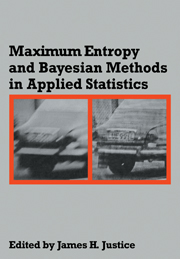 Maximum Entropy and Bayesian Methods in Applied Statistics
Maximum Entropy and Bayesian Methods in Applied Statistics Book contents
- Frontmatter
- Contents
- Preface
- Donors
- Bayesian Methods: General Background
- Monkeys, Kangaroos, and N
- The Theory and Practice of the Maximum Entropy Formalism
- Bayesian Non-Parametric Statistics
- Generalized Entropies and the Maximum Entropy Principle
- The Probability of a Probability
- Prior Probabilities Revisited
- Band Extensions, Maximum Entropy and the Permanence Principle
- Theory of Maximum Entropy Image Reconstruction
- The Cambridge Maximum Entropy Algorithm
- Maximum Entropy and the Moments Problem: Spectroscopic Applications
- Maximum-Entropy Spectrum from a Non-Extendable Autocorrelation Function
- Multichannel Maximum Entropy Spectral Analysis Using Least Squares Modelling
- Multichannel Relative-Entropy Spectrum Analysis
- Maximum Entropy and the Earth's Density
- Entropy and Some Inverse Problems in Exploration Seismology
- Principle of Maximum Entropy and Inverse Scattering Problems
- Index
Maximum Entropy and the Earth's Density
Published online by Cambridge University Press: 04 May 2010
- Frontmatter
- Contents
- Preface
- Donors
- Bayesian Methods: General Background
- Monkeys, Kangaroos, and N
- The Theory and Practice of the Maximum Entropy Formalism
- Bayesian Non-Parametric Statistics
- Generalized Entropies and the Maximum Entropy Principle
- The Probability of a Probability
- Prior Probabilities Revisited
- Band Extensions, Maximum Entropy and the Permanence Principle
- Theory of Maximum Entropy Image Reconstruction
- The Cambridge Maximum Entropy Algorithm
- Maximum Entropy and the Moments Problem: Spectroscopic Applications
- Maximum-Entropy Spectrum from a Non-Extendable Autocorrelation Function
- Multichannel Maximum Entropy Spectral Analysis Using Least Squares Modelling
- Multichannel Relative-Entropy Spectrum Analysis
- Maximum Entropy and the Earth's Density
- Entropy and Some Inverse Problems in Exploration Seismology
- Principle of Maximum Entropy and Inverse Scattering Problems
- Index
Summary
ABSTRACT
The maximum entropy approach to inversion appears at its best when conclusions are to be drawn from very limited information. An example is the estimation of the density profile of the earth (assumed to be spherically symmetric) on the basis of only its mean density and its relative moment of inertia. With conventional methods giving rather unsatisfactory results, the maximum entropy method provides a density profile which agrees surprisingly well with the one presently considered to be the best.
INTRODUCTION
Inverse problems in geophysics frequently confront us with one of two extreme situations. While we generally have a large number of unknowns to estimate, we may also have a tremendous amount of data – actually, more data than we can reasonably process – and more or less elaborate data reduction schemes are employed to reduce the wealth of data to a more manageable size. Of course, this reduction is performed in a way which improves the quality of the retained data in some sense (e.g., increases the signal-to-noise ratio).
At other times we may still have large numbers of unknowns to contend with but very few data. In fact, the data may be so inadequate that any attempt at estimating the unknowns appears bound to fail. It is this situation which I now want to address by means of an example.
- Type
- Chapter
- Information
- Maximum Entropy and Bayesian Methods in Applied StatisticsProceedings of the Fourth Maximum Entropy Workshop University of Calgary, 1984, pp. 254 - 268Publisher: Cambridge University PressPrint publication year: 1986
